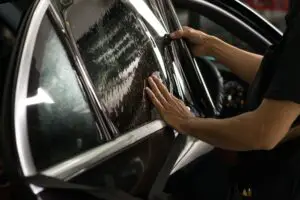Texas established its window tint laws in 2009 and has made sure to update them regularly, constantly tweaking the amount of reflectiveness and darkness required for the window tints to be street legal.
Texas window tint laws have most of the car’s windows set at 25% VLT.
Some windows are immune to this restriction, while others, such as the windshield, have other restrictions, such as being limited to the top 5 inches of the windshield.
Along with all of these rules and regulations, there are various other laws that Texas has set which you have to abide by when it comes to tinting your windows; otherwise, you may get in trouble with the law, so make sure to finish reading this article.
Table of Contents
- 1 How Much Tint Darkness Is Legal In Texas?
- 2 Window Tint Reflection And Tint Colors
- 3 Medical Exemption Of Window Tint Laws In Texas
- 4 Get A Certified Sticker From The Company
- 5 Other Window Tint Law Rules And Regulations In Texas
- 6 Cost Of Car Window Tint In Texas
- 7 Frequently Asked Questions
- 8 Conclusion
How Much Tint Darkness Is Legal In Texas?

Texas has set most VLT limits to 25%. This means that select windows must allow at least 25% of light to enter the vehicle.
While living and driving in Texas, you cannot go below 25%, or else you will be breaking the law.
Tint Darkness Limit For SUVs And Vans
The law states that you can have tints on the windshield for sports utility vehicles and vans, but only if they are over 25% VLT.
These tints cannot be reflective in any case and must be over the AS 1 line set by the manufacturer or suspended to the top 5 inches of the windshield.
While many of these rules are dropped for other windows, the 25% rule is kept for the front seat side windows.
The back seat side windows have no restrictions, meaning you can have whatever tint you want and as dark as you want it.
The rear windows can also allow tints of any darkness, but you will have to use side mirrors if there is a catch. If not, your rear window is limited to 25% VLT.
Tint Darkness Limit For Sedans
Many of the rules that the state of Texas has set for SUVs and vans apply to sedans, which is why I will go over them here on a per-window basis.
1. Front Windshield
The front windshield is also limited to 25% VLT but has its own new rules.
These rules prevent reflective tints from being applied to the windshield, all while limiting them to the top 5 inches or above the AS 1 line of the car.
2. Front Seat Side Windows
You are legally required to apply tints to the front seat side windows with at least 25% VLT or more. Going below this amount will cause issues with law enforcement.
3. Rear Window
Rear windows are allowed to have any darkness you want as long as you use have dual side mirror. If not, you will have to limit the screen by 25%.
4. Back Seat Side Windows
Finally, the back seat side windows can have any darkness you wish them to, giving you the freedom to apply whatever tint you want.
Window Tint Reflection And Tint Colors
- The state of Texas has also set various rules on how much you can reflect light from the window tints and the colors you can apply to them.
- The front-seat side windows of all cars and vehicles must not exceed more than 25% reflectiveness.
- This is the same case for the back seat side windows, which are also limited to 25% reflectiveness.
- Texas has allowed the use of most colored tints on the windows.
- The colors that the state does not allow are as follows:
– Red
– Blue
– Amber
Medical Exemption Of Window Tint Laws In Texas

If you have a medical condition that prevents you from going outside or driving in the sunlight, you will be happy to know that the state of Texas allows for medical exemptions to its window tint laws.
Many people suffer from various conditions that prevent them from coming into contact with the sun’s rays.
This makes it very difficult to abide by the window tint laws as they usually gravitate towards very dark tints, which often are below the required amount set by the state.
Luckily, you can get a signed statement of prescription from your licensed physician or doctor that states that you tint special tints for medical purposes and the reason you need them.
With this, you can apply tints below the 25% VLT requirements set by the state.
Get A Certified Sticker From The Company
Certifying that your window tints are legal and abiding by the state’s rules is as easy as putting a sticker on the windshield.
This makes it easy for law enforcement to identify them, saving you and them precious time and effort. Most states rather have this as a requirement or recommend it severely.
Texas has this as a requirement that you must follow if you are tinting your windows. This certification sticker must be applied to the windshield if you have tinted windows.
This translates to film manufacturers as well, which have to certify that the tints they are manufacturing are legal and abide by the state’s standards.
Other Window Tint Law Rules And Regulations In Texas
Here are various other rules that you must follow if you are living in the state of Texas and have tinted windows:
- If your rear window has tints below 25%, you must use dual side mirrors.
- The state of Texas offers no tint variance at all. You have to abide by the set VLT thresholds to the number.
- If you get your windows tinted, you must have a certification sticker on your car’s windshield.
- Color tints are allowed except for the colors which have been mentioned above.
- People can apply for medical exemptions in the state of Texas.
Cost Of Car Window Tint In Texas
For most vehicles, the price of tinting all the car windows can range from $200 to $250. This is the price range for most basic tints that you can buy.
If you are in the market for tints that are higher in quality, such as ceramic tints, then you will have to pay upwards of $400.
Many of these tints depend on the number of windows, the color, the warranty, and the quality, so make sure to think about all these aspects before buying window tints.
Frequently Asked Questions
Q1. Is 15% Tint Legal In Texas?
15% tints are not legal in Texas for most windows as the state has set a VLT requirement of 25% on them.
Aside from the back seat side windows and rear windows, you cannot use 15% tints in some cases unless you have any form of medical exemption.
Q2. Are 5% Tints Legal In Texas?
This goes without saying that if 15% of tints are illegal in most cases, 5% of tints will be too.
The state only allows 25% tints to be applied to most of their windows and only removes this rule for select windows.
Q3. Is Limo Tint Legal In Texas?
Considering limo tints are also very dark, they too will not follow the tint laws set by the state, making them illegal in most cases.
If you follow further instructions, you can only apply limo tints to the back seat side windows and the rear window.
Q4. Can I Get Pulled Over For Tint In Texas?
If the police do not see a certification sticker, they will likely pull you over. This is also the case if you use illegal colors or use darker tints.
Q5. How Much Is A Tint Ticket In Texas?
If you get a tint ticket for the first time, you can get a fine of $20 to $25, but further tint tickets can cause expenses as high as $275.
Conclusion
Texas tint laws are as standard as they can get.
They have a pretty low threshold for VLT requirements if you compare them to other states, which are great for people who like darker tints.
The state also allows for medical exemptions, which is great for people who have conditions that prevent them from driving with normal tints.
Now that you have read this article, you should have a good understanding of how the law operates in Texas when it comes to window tint laws, and you should be easily able to abide by the rules and regulations set by the state.

I am Tahir Azam, and I have been writing amazing articles for TaxiHack for as long as I can remember. I know everything that is to know when it comes to automobiles and is always on top of industry news and developments. While I am not an expert by any means, I pride myself on knowing the ins and outs of many different problems and, of course, their solutions. The articles on our website are some of the best and well-researched content that you will find, and I spend countless hours making sure this remains to be true. This is why I ask you to take your time out and read some of my articles, especially if you find a topic that resonates with you or is something you are looking into. This way, you will find the perfect mix of information and tips on your desired topic. Learn more about Tahir.



